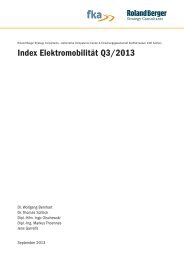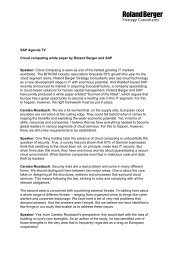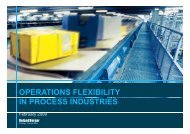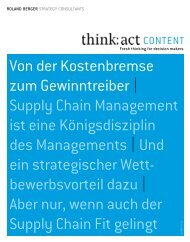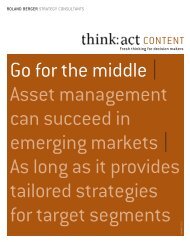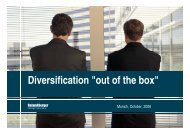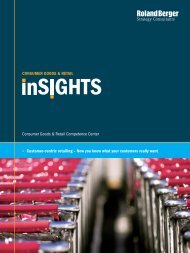act CONTENT "Reinventing corporate headquarters" - Roland Berger
act CONTENT "Reinventing corporate headquarters" - Roland Berger
act CONTENT "Reinventing corporate headquarters" - Roland Berger
You also want an ePaper? Increase the reach of your titles
YUMPU automatically turns print PDFs into web optimized ePapers that Google loves.
ROLAND BERGER STRATEGY CONSULTANTSBIGGER WORKLOAD, LESS PEOPLEAs <strong>corporate</strong> functions have been centralized, thenumber of HQ employees declined.LEVEL OF CENTRALIZATION (%)Strong uptrend75662000-20022003-2005NUMBER OF EMPLOYEES (%)Slight downtrend##2.18 2.112000-20022003-2005The data in our studies of <strong>corporate</strong> headquarters points to similar findings at European companies.Indiscriminate downsizing that takes no account of overhead processes and contentadversely affects a company’s profitability. It follows that, when designing (and sizing) <strong>corporate</strong>functions, the question of effectiveness ("Is the function doing the right things?")should take precedence over the question of efficiency ("Is the function doing thingsright?"). The conclusions drawn will influence both costs and sales. In other words, carefullyexamining how core processes are organized and clarifying who is responsible – a central ora decentralized unit – can have a huge imp<strong>act</strong> on overall <strong>corporate</strong> performance.BOTTOM UP INSTEAD OF TOP DOWNIncreasingly, companies are finding that they can combine the benefits of centralization(the competence to issue guidelines and the ability to bundle purchasing power, etc.) withthe benefits of a distributed structure that is more responsive to the market. Modern communicationtechnologies and flexible, innovative virtual office models facilitate this mix.But what does all this mean in pr<strong>act</strong>ice to the design of <strong>corporate</strong> headquarters? Our experienceshows that a greenfield approach is the best way to combine the benefits of centralizationwith the benefits of decentralization. The resultant target model can then deliver anoptimized <strong>corporate</strong> HQ structure. Our greenfield approach begins by asking some simplequestions:A) What is the future <strong>corporate</strong> management model?B) What tasks is HQ to handle in future? What tasks would be better performed elsewhere?C) How and where can these tasks be bundled sensibly?D) Which people and how many people will these new departments need?BIG BEN – ROLAND BERGERBENCHMARKING DATABASE Corporate center data culled from 241 companies(including relative levels of centralization andoutsourcing) is safely stored in our benchmarkingdatabase. Some of the data has been piecedtogether from high-quality interviews conductedduring <strong>corporate</strong> development projects.Supplementary information derives from thestudies of <strong>corporate</strong> headquarters thatwe performed in 1999, 2002 and 2005.The database thus enables enterprisespecificbenchmarking panels to be producedfor 29 core functions and 120 subfunctions.It can therefore set the ballrolling, stimulat-ing a meaningful discussionof key f<strong>act</strong>ors and sizing issues.It is especially important to accurately anticipate capacity requirements ahead of a reorganizationin order to minimize operating risks. However, it is not always helpful to draw on rawnumbers such as the size of the overall workforce. A <strong>corporate</strong> communications departmentwill not expand continually in line with company growth. Instead, it will grow intermittently asdifferent requirements thresholds are reached and crossed. Acquisitions can suddenlynecessitate the formation of an international team. New legal forms may change the requirementsfor disclosure and reporting. And changes in the media landscape may create a needfor specialists to handle new media.A more sensible way of working toward the optimal constellation is to analyze benchmarkdata. Our view is that it is best to look for patterns that cut across different industry lines. Wehave grouped <strong>corporate</strong> functions into the following clusters:1.) STRATEGIC/MANAGEMENT FUNCTIONS, e.g. management board, strategic planning,investor relations, <strong>corporate</strong> communications2.) FINANCIAL FUNCTIONS, e.g. finance, controlling, accounting, insurance3.) BUSINESS SYSTEM SUPPORT FUNCTIONS, e.g. HR, IT, facility management,occupational safety4.) OPERATING FUNCTIONS, e.g. research &development, purchasing, logistics,qualitymanagement



